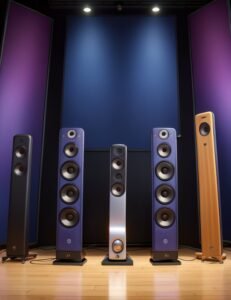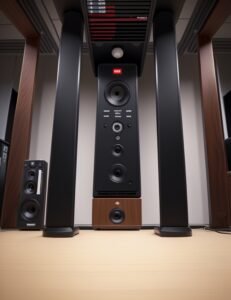Welcome to the fascinating world of sound! These objectives are related to Chapter Sound of Science Fact File Book 2
Have you ever wondered how your favorite song travels from the speakers to your ears, or why some noises are louder than others?
Sound is all around us, shaping our experiences and adding richness to our lives.
In this article, we’ll embark on an exciting journey to explore the wonders of sound, uncovering its mysteries one vibration at a time.
Get ready to dive into the rhythm of sound waves and discover the secrets behind the music of the universe!
Few important terms definitions:-
Few important terms definitions which are related to Chapter Sound are as follows.
-
Sound:
Sound is a form of energy that travels through air, water, or solids in the form of vibrations that can be heard by our ears.
-
Sound Waves:
Sound waves are the vibrations that travel through a medium (like air, water, or solids) and carry sound energy.
-
Frequency:
Frequency refers to how often something happens in a given time. In sound, it describes how many waves pass by in one second and is measured in Hertz (Hz).
-
Pitch:
Pitch is how high or low a sound is. Sounds with high frequencies have high pitches, like a bird chirping, while sounds with low frequencies have low pitches, like a deep rumble.

-
Loudness:
Loudness is how strong or intense a sound is. It’s determined by the amplitude of the sound wave, which is how high the peaks and low the troughs of the wave are.
-
Amplitude:
Amplitude is the measure of the height of a sound wave. A higher amplitude means a louder sound.
-
Hertz (Hz):
Hertz is the unit used to measure frequency. One Hertz equals one cycle per second.
-
Decibels (dB):
Decibels are used to measure the loudness of sound. It’s a unit that compares the intensity of one sound to another. The higher the decibel level, the louder the sound.
-
Soundproofing Material:
Soundproofing materials are used to block or reduce the transmission of sound from one area to another. They absorb or reflect sound waves to minimize noise.
-
Wavelength:
Wavelength is the distance between two consecutive peaks or troughs of a sound wave. It determines the pitch of the sound.
-
Longitudinal Waves:
Longitudinal waves are waves where the particles of the medium move parallel to the direction of the wave. Sound waves are longitudinal waves.
-
Transverse Waves:
Transverse waves are waves where the particles of the medium move perpendicular to the direction of the wave. Light waves are transverse waves.
-
Resonance:
Resonance occurs when an object vibrates at its natural frequency in response to another vibrating object, amplifying the sound.
-
Infrasonic:
Infrasonic refers to sound waves with frequencies below the range of human hearing, typically below 20 Hz.
-
Ultrasonic:
Ultrasonic refers to sound waves with frequencies above the range of human hearing, typically above 20,000 Hz.
Quizzes about Chapter sound:
You can learn more about chapter sound by answering these quizzes.
-
Choose the best answer of Chapter Sound:
-
What is the source of sound in a guitar?
Options: A. Strings | B. Buttons | C. Batteries
Correct Answer: A. Strings
-
In which medium does sound travel the fastest?
Options: A. Air | B. Water | C. Solid
Correct Answer: C. Solid
-
What part of the ear collects sound waves?
Options: A. Earlobe | B. Eardrum | C. Ear canal
Correct Answer: C. Ear canal
-
Unit of measurement for sound?
Options: A. Watt | B. Decibel | C. Newton
Correct Answer: B. Decibel
-
Term for highness or lowness of a sound?
Options: A. Volume | B. Pitch | C. Frequency
Correct Answer: B. Pitch
-
Unit of frequency for sound waves?
Options: A. Hertz | B. Kelvin | C. Joule
Correct Answer: A. Hertz
-
Animal known for exceptional hearing?
Options: A. Elephant | B. Bat | C. Crocodile
Correct Answer: B. Bat
-
Bouncing back of sound waves?
Options: A. Echo | B. Shadow | C. Reflection
Correct Answer: A. Echo
-
Instrument with vibrating reeds?
Options: A. Piano | B. Trumpet | C. Harmonica
Correct Answer: C. Harmonica
-
How does sound travel through a vacuum?
Options: A. Slowly | B. Quickly | C. It doesn’t
Correct Answer: C. It doesn’t
-
Device to measure sound intensity?
Options: A. Spectrometer | B. Seismograph | C. Sound Meter
Correct Answer: C. Sound Meter
-
Outer ear’s primary purpose?
Options: A. Amplify sound | B. Balance | C. Protect eardrum
Correct Answer: C. Protect eardrum
-
Material for absorbing sound waves?
Options: A. Glass | B. Rubber | C. Wood
Correct Answer: B. Rubber
-
Speed of sound in air at room temperature?
Options: A. 330 m/s | B. 1500 m/s | C. 5000 m/s
Correct Answer: A. 330 m/s
-
What is the unit of power for sound waves?
Options: A. Watt | B. Decibel | C. Joule
Correct Answer: A. Watt
-
What property of sound determines loudness?
Options: A. Amplitude | B. Frequency | C. Wavelength
Correct Answer: A. Amplitude
-
Which gas is commonly used to transmit sound in cartoons?
Options: A. Nitrogen | B. Oxygen | C. Helium
Correct Answer: C. Helium
-
Which material is a good conductor of sound?
Options: A. Wood | B. Metal | C. Rubber
Correct Answer: B. Metal
-
What is the range of human hearing in Hertz?
Options: A. 20-20,000 | B. 100-1,000 | C. 5-50
Correct Answer: A. 20-20,000Hz
-
What causes the sensation of sound in the human ear?
Options: A. Light waves | B. Pressure waves | C. Electric currents
Correct Answer: B. Pressure waves
-
Which musical instrument is known for using air columns to produce sound?
Options: A. Drum | B. Flute | C. Guitar
Correct Answer: B. Flute
-
What part of the ear translates sound vibrations into electrical signals for the brain?
Options: A. Cochlea | B. Eardrum | C. Ossicles
Correct Answer: A. Cochlea
-
Which of the following animals does not use echolocation?
Options: A. Dolphin | B. Bat | C. Elephant
Correct Answer: C. Elephant
-
What is the term for a sound that is unpleasant to the ear?
Options: A. Harmony | B. Noise | C. Melody
Correct Answer: B. Noise
-
In which medium does sound travel the slowest?
Options: A. Air | B. Water | C. Solid
Correct Answer: A. Air
-
What is the unit of measurement for the frequency of sound waves?
Options: A. Hertz | B. Decibel | C. Watt
Correct Answer: A. Hertz
-
What is the purpose of the tiny hairs in the inner ear?
Options: A. Balance | B. Amplify sound | C. Convert vibrations to nerve signals
Correct Answer: C. Convert vibrations to nerve signals
-
Which of the following is an example of a percussion instrument?
Options: A. Violin | B. Trumpet | C. Drum
Correct Answer: C. Drum
-
What is the term for the distance between one peak of a sound wave and the next?
Options: A. Wavelength | B. Amplitude | C. Frequency
Correct Answer: A. Wavelength
-
What is the term for the highest point of a sound wave?
Options: A. Crest | B. Trough | C. Wavelength
Correct Answer: A. Crest
-
Which of the following materials is a good insulator of sound?
Options: A. Glass | B. Metal | C. Concrete
Correct Answer: A. Glass
-
What is the medical term for the ringing sound in the ears?
Options: A. Tinnitus | B. Sonar | C. Echo
Correct Answer: A. Tinnitus
-
Which type of wave is a sound wave?
Options: A. Transverse | B. Longitudinal | C. Electromagnetic
Correct Answer: B. Longitudinal
-
What is the frequency range of ultrasonic waves?
Options: A. Below 20 Hz | B. 20-20,000 Hz | Above 20Hz
Correct Answer: Above 20Hz
-
What is the primary function of the ear’s hammer, anvil, and stirrup?
Options: A. Maintain balance | B. Transmit sound vibrations | C. Convert sound to electrical signals
Correct Answer: B. Transmit sound vibrations
-
What is the speed of sound in water?
Options: A. 343 m/s | B. 1500 m/s | C. 1482 m/s
Correct Answer: C. 1482 m/s
-
Which property of a sound wave determines its pitch?
Options: A. Amplitude | B. Frequency | C. Wavelength
Correct Answer: B. Frequency
-
What is the term for the persistence of sound after the source stops producing it?
Options: A. Echo | B. Resonance | C. Reverberation
Correct Answer: C. Reverberation
-
In which part of the ear are the semicircular canals located?
Options: A. Outer ear | B. Middle ear | C. Inner ear
Correct Answer: C. Inner ear
-
What is the term for the perceived highness or lowness of a sound?
Options: A. Volume | B. Pitch | C. Tone
Correct Answer: B. Pitch
-
What is the unit of measurement for the loudness of sound?
Options: A. Watt | B. Decibel | C. Hertz
Correct Answer: B. Decibel
-
Which type of waves are used in sonar to detect underwater objects?
Options: A. Radio waves | B. Sound waves | C. Light waves
Correct Answer: B. Sound waves
-
What is the term for the interference of sound waves resulting in a louder sound?
Options: A. Amplification | B. Resonance | C. Reverberation
Correct Answer: B. Resonance
-
What part of the ear is responsible for converting sound vibrations into nerve impulses?
Options: A. Cochlea | B. Auditory nerve | C. Ossicles
Correct Answer: B. Auditory nerve
-
What is the minimum number of compressions and rarefactions needed for one complete cycle of a sound wave?
Options: A. 1 | B. 2 | C. 3
Correct Answer: B. 2
-
Which animal is known for producing infrasound for communication?
Options: A. Elephant | B. Bat | C. Whale
Correct Answer: A. Elephant
-
Which animal is known for producing ultrasound for communication?
Options: A. Elephant | B. Bat | C. Whales
Correct Answer: B. Bat
-
What property of a sound wave is associated with its quality or color?
Options: A. Amplitude | B. Timbre | C. Frequency
Correct Answer: B. Timbre
-
Which part of the ear helps in localizing the direction of a sound source?
Options: A. Outer ear | B. Inner ear | C. Middle ear
Correct Answer: A. Outer ear
-
In which medium does sound travel at a constant speed regardless of frequency?
Options: A. Air | B. Water | C. Vacuum
Correct Answer: A. Air
-
Which musical instrument produces sound by vibrating a column of air in a pipe?
Options: A. Clarinet | B. Saxophone | C. Trombone
Correct Answer: A. Clarinet
-
What part of the ear is responsible for detecting changes in head position?
Options: A. Cochlea | B. Semicircular canals | C. Auditory nerve
Correct Answer: B. Semicircular canals
-
Which type of waves are used in medical ultrasound imaging?
Options: A. Radio waves | B. Microwaves | C. Ultrasonic waves
Correct Answer: C. Ultrasonic waves
-
What is the primary function of the pinna (external ear)?
Options: A. Amplify sound | B. Collect sound | C. Convert sound to electricity
Correct Answer: B. Collect sound
-
Which is not a form of energy?
Options: A. Light | B. Sound | C. Metal
Correct Answer: C. Metal
Q.56. Sound is made when something _______.
Options: A. Vibrates B. Resonates C. Echoes
Correct Answer: A. Vibrates
Q.57. In a __________, it is a string which vibrates.
Options: A. Guitar B. Violin C. Piano
Correct Answer: A. Guitar
Q.58. __________ can only move when there is material to move through.
Options: A. Sound B. Light C. Electromagnetic waves
Correct Answer: A. Sound
Q.59. Sound cannot travel through a __________.
Options: A. Vacuum B. Medium C. Solid
Correct Answer: A. Vacuum
Q.60. ___________ is the distance between two compressions or rarefactions.
Options: A. Wavelength B. Amplitude C. Frequency
Correct Answer: A. Wavelength
Q.61. Bats and dogs can detect _________.
Options: A. Ultrasound B. Infrasound C. Echoes
Correct Answer: A. Ultrasound
Q.62. Sounds above 20.000Hz are called __________.
Options: A. Infrasound B. Audible sound C. Ultrasound
Correct Answer: C. Ultrasound
Q.63. Sound waves are ___________ waves.
Options: A. Transverse B. Longitudinal C. Electromagnetic
Correct Answer: B. Longitudinal
Q.64. Sound waves take about ___ seconds to travel one kilometer.
Options: A. 1 B. 2 C. 3
Correct Answer: C. 3
Q.65. A _________ is a regular backward and forward movement.
Options: A. Wave B. Vibration C. Frequency
Correct Answer: B. Vibration
Q.66. The ___________ of a sound is the number of sound vibrations set up in 1 second.
Options: A. Amplitude B. Frequency C. Wavelength
Correct Answer: B. Frequency
Q.67. The Human ear is able to detect sound in a range _________.
Options: A. 20-20,000 Hz B. 100-1,000 Hz C. 5-50 Hz
Correct Answer: A. 20-20,000 Hz
Q.68. ___________ is used in Hospitals for breaking down kidney stones.
Options: A. X-rays B. Ultrasound C. Radio waves
Correct Answer: B. Ultrasound
Q.69. Sound below _____ are called infrasound.
Options: A. 20 Hz B. 200 Hz C. 2,000 Hz
Correct Answer: A. 20 Hz
Q.70. _____________ is used for monitoring earthquakes and studying rock information.
Options: A. Sonar B. Seismology C. Spectroscopy
Correct Answer: B. Seismology
Q.71. __________ can be detected by whales, elephants, and rhinoceroses.
Options: A. Infrasound B. Ultrasound C. Audible sound
Correct Answer: A. Infrasound
Q.72. The loudness of a sound depends on the height of the sound waves __________.
Options: A. Amplitude B. Frequency C. Wavelength
Correct Answer: A. Amplitude
Q.73. Loudness of a sound can be measured in ___________.
Options: A. Watts B. Decibels C. Hertz
Correct Answer: B. Decibels
Q.74. Pitch of a sound is measured in ________.
Options: A. Watts B. Decibels C. Hertz
Correct Answer: C. Hertz
Q.75. Noise is measured in __________.
Options: A. Watts B. Decibels C. Hertz
Correct Answer: B. Decibels
Q.76. Noise levels can be measured with a ___________.
Options: A. Ruler B. Thermometer C. Sound meter
Correct Answer: C. Sound meter
Q.77. A sound meter converts _________ energy into electrical energy.
Options: A. Acoustic B. Light C. Mechanical
Correct Answer: A. Acoustic
Q.78. The relationship between the speed, frequency, and wavelength of a sound can be shown by the equation:______.
Options: A. v = f × λ B. v = λ/f C. f = v/λ
Correct Answer: A. v = f × λ
Q.79. Too much noise causes _________ pollution.
Options: A. Air B. Water C. Noise
Correct Answer: C. Noise
Q.80. Sound with a high frequency have a _______ pitch.
Options: A. Low B. High C. Moderate
Correct Answer: B. High
You can also download these objectives:









1 comment